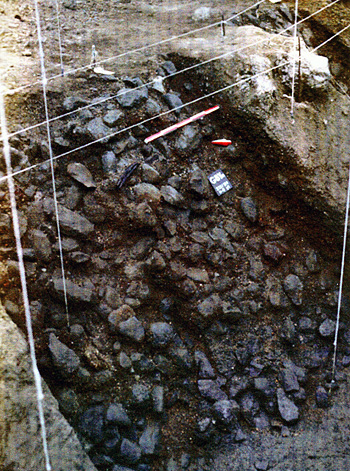Book Review

NIRA ALPERSON-AFIL & NAAMA GOREN-INBAR. The Acheulian site of Gesher Benot Ya'aqov. Volume 2: ancient flames and controlled use of fire. xxviii+120 pages, 82 colour & b&w illustrations, 24 tables. 2010. Dordrecht, Heidelberg London & New York: Springer Science + Business Media; 978-90-481-3764-0 hardback £90; 978-90-481-3765-7 e-book; DOI: 10.1007/978-90-481-3765-7.
Review by Robin Dennell
Department of Archaeology, University of Sheffield, UK (Email: r.dennell@sheffield.ac.uk)
The controlled use of fire was one of the great accomplishments of our remote ancestors. Among its many consequences were warmth, defence against predators at night, a focus for group activity ('hearth and home'), all the dietary and social consequences of cooking and, quite probably, the ability to survive winters in ice-age Europe and Asia. For these reasons, considerable attention has been paid to establishing when fire became a routine part of early human society. This volume makes a fundamental contribution to answering this question.
Gesher Benot Ya'aqov in Israel (often abbreviated to GBY) is one of the Early Palaeolithic 'flagship' sites of Asia, and may, besides testimonies for the earliest use of fire, also have the earliest evidence for the hunting of elephants, the processing of plant foods and the shaping of wood (Goren-Inbar et al. 2000, 2002a). It lies in the northern part of the Dead Sea Rift, along the River Jordan. The strata are severely tilted; the stratigraphy is very complex, and the excavation and subsequent analysis have required much patience and skill. Because the site is waterlogged, preservation of organic plant material was often excellent, as shown in the first volume on this site (Goren-Inbar et al. 2002b). The site contains 34m of lacustrine or lake-margin deposits, capped by some fluvial ones. Palaeomagnetic analyses show that the Brunhes-Matuyama boundary lies 4m below one of the main archaeological horizons, which is thus dated to slightly after 0.78 million years ago: the total length of occupation was c.100 000 years (MIS 19).
As argued in great detail in this volume, GBY may have the earliest evidence for the controlled use of fire. The evidence is exceedingly ephemeral, as there were no obvious burnt areas, hearths or deposits of ash and burnt material; instead, the evidence consists of 'invisible hearths' — i.e. concentrations of burnt micro-artefacts (pieces 2-20mm long) and burnt plant material. Here, the authors independently developed the same methodology as has been applied to late glacial and Mesolithic European sites (Sergant et al. 2006) by meticulously documenting clusters of burnt micro-artefacts and small fragments of burnt plant material (mostly wood, but some fruits and seeds). These were found in all excavated archaeological levels but their location varied, so different parts of the site were used at different times. These clusters, the authors convincingly argue, resulted from hominin activity. Stratigraphic evidence argues against peat fires and volcanic activity as causes. Lightning strikes are the most likely natural agent but are unlikely to have caused natural conflagrations. Hominins are thus considered the most likely agent: because, first, the incidence of burnt material is far lower than might be expected from lightning strikes; and second, its distribution clustered repeatedly. Does, however, the fact that hominins may have used fire (from, for example, a nearby lightning strike) mean that they could make it on a regular basis? I was initially sceptical but now think it does, because the evidence for its use is so repetitive throughout the total 100 000-year long span of occupation.
This volume has three important implications. First, the handaxes and cleavers at GBY are like those found in Africa, and may indicate an influx of immigrants from Africa c. 800 000 years ago. As the authors suggest, these immigrants might also have brought the ability to make fire — if so, similar but earlier evidence should be found in Africa. Secondly, Europe was first colonised by at least a million years ago, yet its earliest reliable evidence for fire is only some 400 000 years old: as Paola Villa argues in her foreword, the absence of evidence for fire in Europe before this date needs revisiting, and this volume shows how this might be done. The third and perhaps most important aspect of this volume is that it presents a clear methodology for how ephemeral traces of 'invisible hearths' can be detected in early Palaeolithic sites: it opens a window on our remote past, and shows how similar and perhaps even older evidence might be obtained.
The volume is impeccably produced, and presents an overview of past work (chapter 1), a clear outline of the research methodology (chapter 2), a wealth of raw data from 16 levels (with abundant photographs) in chapter 3, and a comprehensive overview in chapter 4. Although a very specialised (and expensive) volume, no serious researcher of the early Palaeolithic should ignore it — this volume is arguably the most important taphonomic investigation of an early Palaeolithic site from the last 20 years.
References
- GOREN-INBAR, N., C.S. FEIBEL, K.L. VERSOUB, Y. MELAMED, M.E. KISLEV, E. TCHERNOV & I. SARAGUSTI. 2000. Pleistocene milestones on the Out-of-Africa corridor at Gesher Ya'aqov, Israel. Science 289: 944-7.
- GOREN-INBAR, N., G. SHARON, Y. MELAMED & M. KISLEV. 2002a. Nuts, nut-cracking, and pitted stones at Gesher Benot Ya'aqov, Israel. Proceedings of the National Academy of Science USA 99(4): 2455-60.
- GOREN-INBAR, N., F. WERKER & C.S. FEIBEL. 2002b. The Acheulean site of Gesher Benot Ya'aqov, Israel. 1: the wood assemblage. Oxford: Oxbow.
- SERGANT, J., P. CROMBE & Y. PERDAEN. 2006. The 'invisible hearths': a contribution to the discernment of Mesolithic non-structured surface hearths. Journal of Archaeological Science 24: 439-46.



